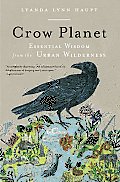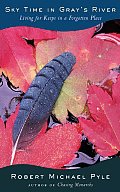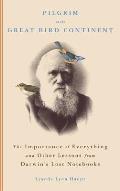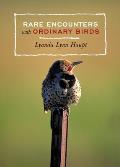
I didn't know how to break it to my neighbor Jane, so I decided to just pick up the phone and say it straight. Thank god I got the answering machine, as this is not the sort of thing anyone wants to hear before coffee. "Honey, there's a dead bird on your roof." The bird was lying there just beneath the peak, in crumpled disarray. Feet up, head down, feathers mussed, neck twisted in that awkward way of dead things. I was probably the only one on earth who could see it, here in my upstairs study, with an aerial view of my dear friend's rooftop across the street. At first I rather hoped I might be wrong — that this might simply be a bird-shaped bit of moss or something, and that my mind was making it into a bird, just as on lakeside walks my hopeful mind makes floating wood into rare geese. But, no, the more I looked at it, the more birdish it seemed, and I supposed it would turn out to be the most common of dead urban birds this time of year — a young, hatch-year starling. But through binoculars I saw buffy brown feathers. Intrigued, I pulled out more serious optics. Through my 60x magnification spotting scope, which I focused through the study window, over the phone line, and onto Jane's roof, the bird revealed itself to be the second-most-common dead urban bird of the season — a hatch-year house sparrow. Not a rarity by any stretch, but still singular. How did it get there? Birds rarely just fall dead out of the sky, and they hardly ever die out in the open. Something must have brought this bird here, something that preys on naive young birds — a sharp-shinned hawk, perhaps, or a crow, or a cat, though I'd never seen any of these things on Jane's roof, and whatever brought the bird there hadn't bothered to eat it.
Normally I would investigate a bird that has died in my neighborhood, ever in search of stories from the wild lives around me, which are revealed in deaths as much as in the observation of living creatures. But even I, with these macabre proclivities, was not about to kill myself by climbing up Jane's roof for a dead house sparrow. Still, I'm trying to get some writing done. How am I supposed to think when I have a dead bird to look at, and its hidden story to ponder?
"Death is a common companion of anyone who lives in the country," wrote Robert Michael Pyle in Sky Time in Gray's River. "Predation takes place daily, and if you are observant, you can't help seeing it now and then. A sharp-shinned hawk has lately taken up residence, and every now and then I catch its swift brown blur past the window, and then a little heap of feathers from a junco or a jay...The city insulates us from death; the country rubs our noses in it."
 I live in West Seattle, a short bus ride from downtown. If I walk 10 minutes to the west, I am smack in the middle of Lincoln Park, with its acres of forest brushing a trail along the Puget Sound shoreline. If I walk 20 minutes east, I'm in the Target parking lot.
I live in West Seattle, a short bus ride from downtown. If I walk 10 minutes to the west, I am smack in the middle of Lincoln Park, with its acres of forest brushing a trail along the Puget Sound shoreline. If I walk 20 minutes east, I'm in the Target parking lot.
I love Pyle's writing, and I long for a rural existence, but this line of thinking stops me short. The city insulates us from death? Tell that to the crow who brought its tasty dead rat into my back yard, its turned-out skin shimmering the most vivid red I'd ever seen. "Oh, that's pleasant," I said aloud when I saw that bits of bloody rat hide had been scattered about the yard. But when my husband Tom got home from work and I went to tell him about the nice little pick-up job I'd saved for him, the skin was gone. Just gone.
Tell that to the opossums who patter so myopically across our neighborhood streets at night, their prehistoric noises so pointy, and only sometimes make it all the way to the other side before being mowed over by some hapless teenager in a rush to return his father's car before midnight. We see them in the morning sometimes, don't we? Crows at the side of their carcass, eating breakfast.
 Tell that to the Cooper's hawk that hit the window of my uncle's house near the highway, or the rufous hummingbird caught by my neighbor's cat.
Tell that to the Cooper's hawk that hit the window of my uncle's house near the highway, or the rufous hummingbird caught by my neighbor's cat.
Tell it to the thousands of unseen organisms whose living and dying sifts and renews the soil in which I plant my backyard pole beans and plum tomatoes. Or the slugs I kill in my organic garden with non-toxic Sluggo when my vegetarian-evangelist daughter isn't looking.
Walking at Lincoln Park the other day, I found a grassy circle filled with hundreds of gray-blue feathers. Evidently a kingfisher had been entirely exfoliated on the spot. ("It's not a tree," Tom told me as I knelt there, piecing a whole wing's-worth of primary and secondary feathers into a fan, "it can't be exfoliated." Still, it seemed the right word, as I pictured some accipiter, a cooper's hawk, probably, plucking wildly.)
But, oh dear, this is not supposed to be an essay about dead birds. Not at all. This is an essay about life, the wild life that surrounds us, constantly, vitally, gorgeously, and messily, whether we notice it or not. And it is an argument for noticing. No matter where we live, no matter how urban our dwelling, we are surrounded by wild stories, written in animal alphabets — sometimes bodies, yes, but also feathers, scat, tracks, trails, nests, bits of fur, bones, pellets, and leavings of all sorts, intimations of presences, and of absences. The more we watch for them, the more we see, and some will toss themselves right in our path.
 True, our findings may not normally be as varied, or as thrilling, or perhaps not as traditionally beautiful as if we could spend our days in diverse, wild, rural places. But it is from our home places that we act as ecosystemic creatures, sharing the stuff of the earth with all other beings as we eat, dwell, compost, flush, flourish, and die. We think of ourselves as most connected to nature when we place ourselves in the farther-flung wild, on high altitude mountain trails or stretches of untouched ocean sand, and I absolutely believe that wilderness sojourns are both renewing and utterly essential. But it bears remembering that we connect most concretely to wild nature from our home, and in the way that we live there.
True, our findings may not normally be as varied, or as thrilling, or perhaps not as traditionally beautiful as if we could spend our days in diverse, wild, rural places. But it is from our home places that we act as ecosystemic creatures, sharing the stuff of the earth with all other beings as we eat, dwell, compost, flush, flourish, and die. We think of ourselves as most connected to nature when we place ourselves in the farther-flung wild, on high altitude mountain trails or stretches of untouched ocean sand, and I absolutely believe that wilderness sojourns are both renewing and utterly essential. But it bears remembering that we connect most concretely to wild nature from our home, and in the way that we live there.
The morning after first spotting the rooftop house sparrow, I checked in to see how it was doing. It had been moved about a foot to the left, and turned right-side up. There was now a rather large stick next to it. A crow, with a branch for its nest in tow, must have stopped to have a look-see and forgotten its stick when it left. It's well past nest-building season, but I've noticed several crows carrying sticks in the last couple of weeks, as they do in early spring. I am guessing the nearly-grown chicks are hard on the nests, and their structure often needs a little late-season shoring up. I am glad to have been a witness to this small story. (And lest anyone worry that I am still watching a decomposing sparrow when I should be writing, I should mention that Jane's husband put up a ladder and sprayed the bird down with a hose.)
No matter where we dwell, we can make it an element of our daily life to walk across our home thresholds and into the world as if onto a forested path. Carry a notebook, some binoculars, maybe a handlens, and you will see more than you thought possible. Pick a subject — birds, mushrooms, dragonflies, ferns — and cultivate an urban-wild obsession with your newfound love. We may live in cities and suburbs, but we are surrounded at each turn by news from a wilder earth, there for the noticing, offering us education, intimacy, and delight.